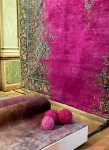Tree of Life

The Tree of Life is a powerful and universal symbol that transcends cultural and religious boundaries, often representing the interconnectedness of all life and the cyclical nature of existence. It has deep roots in various mythologies, philosophies, and spiritual traditions worldwide. When examining the symbolism of the Tree of Life and connecting it to the description of a rug with the ‘Garden of Paradise’ motif designed by Eva Nemeth, we can explore the rich layers of meaning embedded in the symbol and the artwork.
In the context of the rug designed by Eva Nemeth, which features an abstract rendition of the ‘Garden of Paradise’ motif, there is a captivating blend of cultural and artistic influences. The Garden of Paradise, often associated with themes of abundance, beauty, and harmony, can be seen as a microcosm within the more prominent symbolism of the Tree of Life. As a woven tapestry, the rug serves as a canvas for expressing these profound ideas.
The act of weaving itself can be symbolic, reflecting the interconnected threads of life and the intricate patterns that emerge from the interplay of various elements. The rug represents the artist’s interpretation of paradise, where the threads and colours come together in a harmonious dance.
Just as the Tree of Life symbolises the cyclical nature of existence, the rug, woven in France in the early 70s, becomes a tangible artefact reflecting a specific moment in time. The cultural context of the design, influenced by oriental weavings and crafted by a Hungarian artist, adds another layer of complexity to the symbolism. It becomes a bridge between different cultures and artistic traditions, embodying a synthesis of diverse influences.











